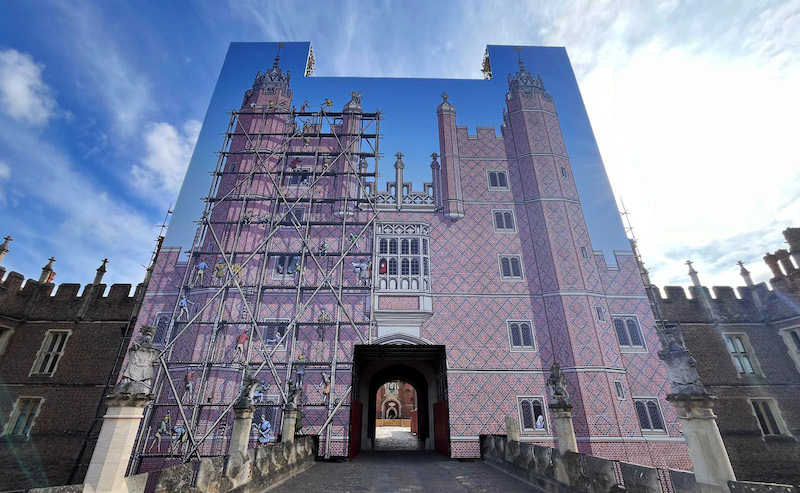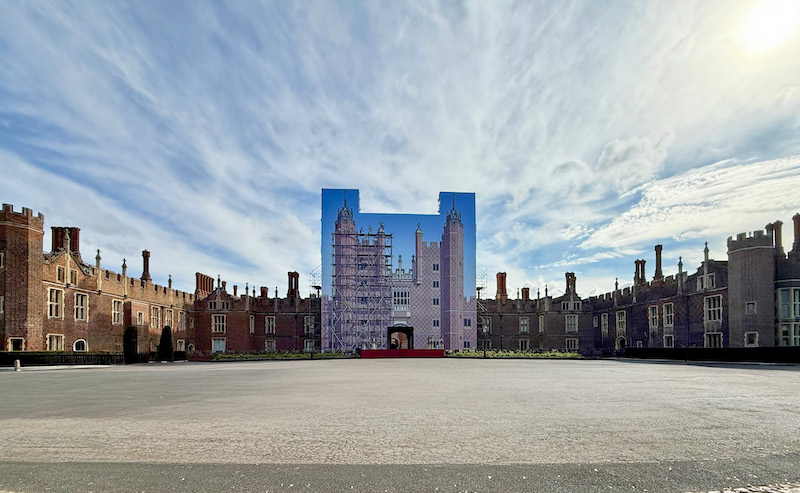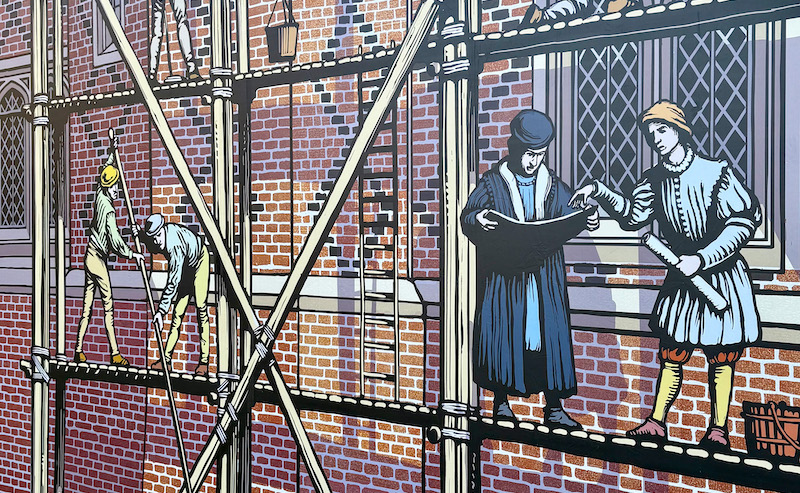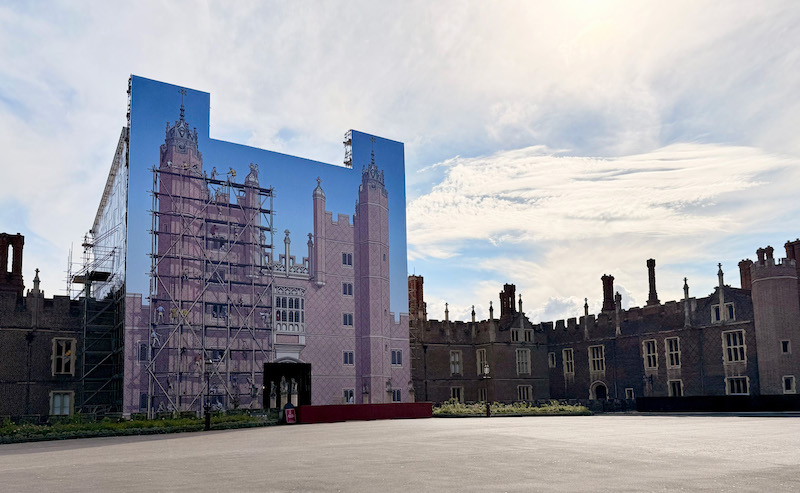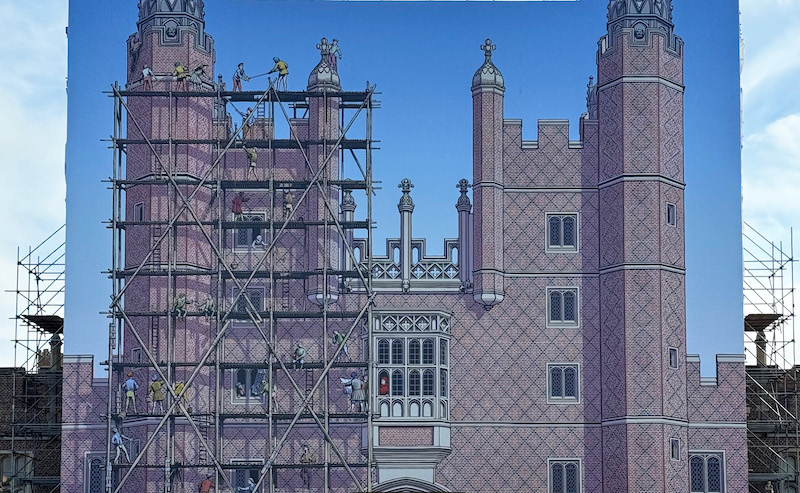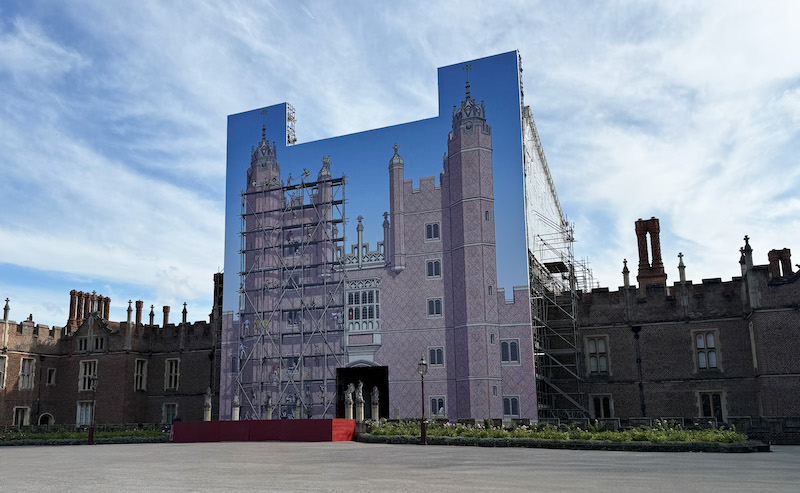Hampton Court Palace
THE LOCATION
Hampton Court Palace is one of Britain's most recognisable and historically significant royal sites. Founded in the early 16th century and extensively developed during the Tudor and Baroque periods, the palace and its grounds draw millions of visitors each year. The Great Gate House — a focal point of the palace — sits on the main visitor route and acts as both an architectural landmark and a practical pinch-point for pedestrian flow.
When conservation work is required on such buildings, contractors must balance essential access and protection with the visitor experience and the integrity of the site. The Great Gate House project involved careful façade repairs to masonry and architectural details. Work needed to happen with minimal disruption to public access while being respectful to the palace's heritage status and to the public who encounter the site daily.
THE BRIEF
Historic Royal Palaces engaged Embrace to provide a scaffold wrap solution that would conceal scaffolding and protect the works while enhancing, rather than detracting from, the visitor experience. Key requirements were:
- Printing the client's design that harmonised with the historic architecture and acknowledged the site's story.
- Robust engineering to accommodate irregular elevations, the archway and towers, and heavy foot traffic nearby.
- A finish that maintained dignity and authenticity for a heritage setting — the wrap needed to feel like part of the palace's narrative, not a billboard.
- Clear communication to visitors about the conservation work underway, without obstructing access or sightlines.
- Responsible end-of-life handling for the materials used.
The client wanted a visually engaging trompe l'œil approach: their illustrated interpretation showing the Great Gate House during an earlier period, with artisan tradespeople at work — a storytelling device to connect visitors with the conservation process.
THE SOLUTION
Embrace printed and installed a 660m² printed scaffold wrap configured in an H-shaped layout to suit the geometry of the Great Gate House. The panel arrangement (approximately 23m wide by 29m high) spanned the two towers, the central archway and the adjoining bridge, working with the existing scaffold geometry and tying into the moat-side legs.
Engineering and installation
To respect the building's complex lines, Embrace manufactured a bespoke offset frame. This custom frame provided precise alignment at the façade and ensured the printed artwork matched architectural features at eye level and from common visitor approaches. The offset frame also created a stable fixing platform that reduced load on scaffold members and enabled safer installation in a high‑traffic public space.
Artwork and heritage sensitivity
The wrap followed the client-supplied trompe l'œil artwork: a historically informed illustration of the Great Gate House as it might have appeared in 1514, showing artisan tradespeople at work on timber scaffolds. This approach achieved several goals at once — it masked the practical machinery of conservation with a period-appropriate scene, celebrated the craft of conservation, and turned an obstruction into an interpretive moment for visitors.
Material choices and sustainability
For this installation we used robust PVC-based printed materials appropriate for the scale and expected term of display. On this occasion the materials were were selected for durability and weather performance to meet the client's requirements for a multi-month, high-visibility installation.
Embrace remains committed to responsible material handling. At the end of the display period the wrap will be processed through Embrace's waste-to-recycling scheme and converted into traffic cones and bollards for reuse in the UK via accredited partners. As part of Embrace's broader sustainability programme, the project's end-of-life recycling is paired with tree-planting: 650 trees will be added to the Embrace Global Forest to offset lifecycle impacts and support biodiversity.
Visitor experience and communication
Rather than a plain barrier, the finished wrap created a narrative moment at the palace entrance. Visitors passing through the Great Gate House encountered a vivid, historically textured scene that explained — visually and immediately — the nature of the conservation work taking place. The trompe l'œil both protected the works and turned waiting or rerouted footfall into an opportunity for engagement and appreciation of the restoration process.
Project delivery
Working within the constraints of a busy heritage site demanded close coordination with Historic Royal Palaces, site contractors and conservation teams. Embrace scheduled installation to avoid peak visitor periods and implemented a robust safety plan for both the fitters and palace visitors. The bespoke frame, pre-assembled sections and experienced installation team helped to minimise on-site time and avoid unnecessary disruption.
CONCLUSION
The Hampton Court Palace scaffold wrap demonstrates how well-considered graphic and engineering solutions can transform essential conservation scaffolding into a visitor-focused asset. Embrace delivered a heritage-sensitive, visually arresting trompe l'œil installation that respected the architectural context, supported the conservation narrative and addressed practical site needs.
Project outcomes at a glance:
- 660m² printed scaffold wrap in an H-shaped configuration.
- Bespoke offset frame for precise alignment and reduced scaffold loading.
- Historically informed trompe l'œil client artwork that enhances visitor understanding.
- Materials chosen for durability with responsible end-of-life recycling.
- End-of-life recycling through accredited partners, conversion into traffic cones and bollards, and 650 trees pledged to the Embrace Global Forest.
Greg Forster, Managing Director at Embrace commented:
Working on a heritage project like this for Historic Royal Palaces is a real honour. Here, the artisan craftsmen and women are literally working behind the wrap to preserve the building for future generations. Our installation had to tell that story sensitively — to protect the conservation works, to respect the palace's character, and to give visitors a meaningful connection to the heritage being preserved.
The project was completed on time and within budget, reassuring our client that large-scale, sensitive heritage projects can benefit from robust, carefully designed building-wrap solutions that balance technical performance with public-facing storytelling.

